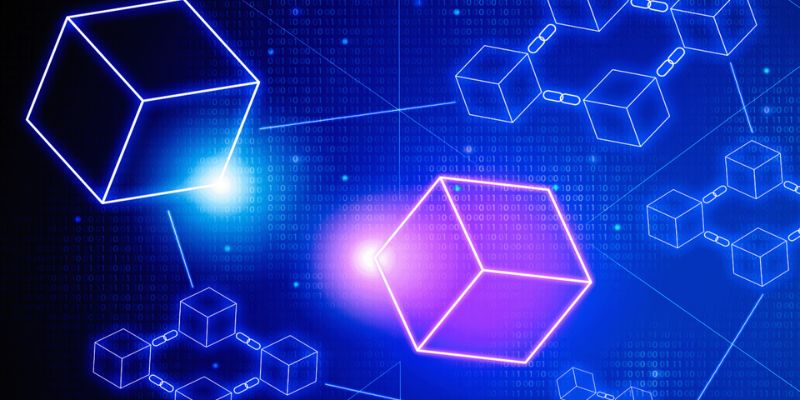Dive into the mechanics of blockchain technology, the puzzle that’s reshaping our digital world, in this beginner’s guide. It’s not just tech talk – I’ll show you how this tool is breaking new ground. We start by decoding blockchain basics and the power behind its shared data. Imagine a world where every transaction is safe, open, and connected – that’s blockchain. Next up, we’re cracking the codes that keep all your info secure. Trust me; you’ll feel like a digital locksmith! Then, we’ll explore smart contracts and the rules that every computer agrees on. No jargon, just plain talk. And finally, see how blockchain checks each digital move, keeping everyone honest. Ready to unlock the secrets of blockchain? Let’s go!
Decoding Blockchain Fundamentals and Distributed Ledger Technology
Understanding the Core Concepts of Blockchain
Blockchain starts with simple ideas. Think of it as a digital ledger. Just like a notebook you use to track your savings. But instead of one person keeping the notebook, everyone has a copy. Each time money moves, everyone writes it down.
Each record in this digital notebook is a block. These have to match across all the copies. A special math puzzle keeps the blocks safe. It’s like a lock that only the true record can open.
Distributed Ledger Technology: The Backbone of Decentralization
Distributed ledger technology (DLT) is like a shared folder on a computer network. But nobody owns it alone, and everyone can see the updates. Footprints of every change stay forever.
DLT is why no single person controls the blockchain. Instead, trust is spread out. People run nodes. A node is a computer linked to the blockchain network.
Nodes do a vital job. They check new blocks to be safe and true. It’s like when you get a new game. You would check it’s safe before letting it run on your computer.
Using blockchain, your friends can send you digital money, even from far away. They send the money, and blockchain makes sure it’s safe and follows the rules. It’s like a game where everyone follows the same steps to play right.
Blockchain is secure because it’s hard to change old records. This keeps your money safe.
Every user has a special key to access their stuff in the blockchain. It works like a secret code that only they should know. They use this code to prove who they are, without telling anyone else the code.
Big ideas in blockchain are about working together but not needing to trust a single player. It spreads out power and control. This is important for freedom and security in our digital world.
One puzzle in blockchain is called proof of work. It makes sure no one cheats. To add a new block, you have to solve a hard math problem. It’s like a ticket to join the game.
There’s also proof of stake. It’s different. You show trust with a share of digital money. The more you hold, the more trust you get. It’s like having a bigger vote in group choices.
In blockchain, your stuff moves in packets, called transactions. These go into blocks after everyone agrees they’re okay. It’s teamwork in action.
Smart contracts are rules written in code. They work on their own when conditions are met. Imagine a vending machine. You put money in, select the item, and the item comes out. Smart contracts work like that, but for many kinds of deals.
The real magic is how blockchain ties all this together. It’s a system that’s hard to break or cheat. It stays honest. With everyone watching and running the rules, it works well and keeps our digital stuff safe.
Blockchain technology keeps on growing and changing. It’s like a living city, expanding and updating. Some worry it uses too much power. Others work on new ways to do the same work with less.
Those were the basics. Now imagine you can track anything: games, gifts, and even votes. That’s the power of blockchain. It’s changing how we think about trust and trade on the internet.
The Pillars of Blockchain Security: Cryptography and Hash Functions
Exploring Blockchain Cryptography and Encryption
Blockchain is like a fort for your digital stuff. It keeps your data safe using two big tools: cryptography and encryption. These are fancy words for secret codes that protect information. Think of cryptography like the walls of the fort, where encryption is the guards who only let in folks with the right password. When you use blockchain, these codes help make sure no one can mess with your data.
Every user has a special key, like a super secret password, that lets them into their slice of the blockchain. This key is a bunch of letters and numbers that’s just for them. It’s made through neat math problems that are super hard to guess. These keys seal your transactions so only you and the person you’re dealing with can see them.
Don’t worry if it sounds tricky. When you send money or messages, blockchain does the heavy lifting. It locks your secrets up tight and checks that everything is as it should be. You won’t even know it’s happening, but it’s working to keep your transactions safe.
Hash Functions: Ensuring Integrity and Immutability
Hash functions are another piece of the puzzle. These are recipes to turn any info into a short code, called a hash. Every time you put the same info into the recipe, you get the same hash. But, if you change just one tiny bit, the hash comes out all different.
These hashes help make sure that the stuff you put on the blockchain stays the same. If someone tries to mess with it, the hash will change, and everyone will know. It’s like a tamper-proof sticker on medicine bottles.
Each block in your blockchain is like a digital box that holds a bunch of transactions and their hashes. Blocks are linked together because each one holds the hash from the one before it. If a sneaky hacker changes an old transaction, the hash won’t match up anymore. That’s how everyone knows something’s fishy.
Hashes are also why new blocks take some work to make. They make sure no one can fiddle with the blockchain without doing a lot of hard work to keep the hashes in line. This is called the mining process, and it’s part of the job of keeping the blockchain safe and sound.
See, blockchain is a smarty-pants way to store data and keep it safe. With secret keys and hash recipes, it’s a fortress for your digital actions. It makes sure your information stays the same, from the time you put it in all the way to the end. All this magic happens behind scenes so you can just enjoy using blockchain without worry.
The Essence of Blockchain Operations: Smart Contracts and Consensus Algorithms
Smart Contracts: Automating Trust and Agreements
Imagine if you could seal a deal without paperwork or a handshake. This is where smart contracts kick in. They are like vending machines for agreements. You put in a coin, and out pops candy. In blockchain, you put in data, and out comes action. No middlemen, no waiting. Smart contracts run on code and work on if-this-then-that logic. They self-run and self-enforce tasks based on rules everyone can see but no one can bend.
Blockchain is a team sport, and smart contracts are the players. They follow the blockchain fundamentals, running on a distributed ledger technology. This means smart contracts are shared and checked by many computers. They help make deals fast and sure. Trust comes from code, not people. This is big for business, big for law, and big for how we swap stuff.
Achieving Consensus: Proof of Work vs. Proof of Stake
Blocks in blockchain need nodding heads to join the line. That’s the consensus. It’s like a group high-five, saying, “Yes, this transaction is cool.” We have two main ways to get there: proof of work and proof of stake. Proof of work is like a math race. Computers solve puzzles to add a block. This takes power and time but keeps the chain safe.
Proof of stake is different. It’s like a game of chance, but with a twist. Your chance to add a block depends on how many coins you hold and are willing to “lock in” as stake. It’s greener and faster than proof of work. Yet, each has a role. They give us blockchain consensus algorithms, keeping everything in order.
Consensus is key in blockchain cryptography. It’s what makes the system tick. Without consensus, there’s no agreement on what’s true. And in the blockchain world, truth lives on trust. So, we use algorithms to find consensus. This way, the chain grows strong, one block after another.
The beauty of smart contracts and consensus lives in decentralization. They trust no single player but the whole game. They let us share ledgers of info across the globe. Each block, each vote, secures a little more trust. They turn the peer-to-peer network into a web of certainty. This is the magic of blockchain encryption, where data locks down tight.
In short, we build trust by code, we agree by math, and we trade by tech. Welcome to the solid world of blockchain, where smart contracts and consensus hold the power. They change the game of how we make promises and keep them. That’s a big deal, and it’s just the start.
Ensuring Seamless Blockchain Functionality: Nodes and Transaction Verification
How Node Verification Sustains the Blockchain Ecosystem
Nodes keep blockchains safe and up to date. They store a copy of every deal. Every node has this same list. This keeps all data true and hard to hack. When new transactions happen, nodes must agree. This is called node verification. All nodes work together to check new data. They use rules known as consensus algorithms.
A consensus algorithm is like a game’s rules. They say how nodes agree on new transactions. One known type is proof of work. It makes solving puzzles a must for new blocks. Another type is proof of stake. It lets owners of more coins vote on new blocks. Each method helps secure the blockchain in a unique way.
Nodes also stop cheats by checking if coins are real. They make sure no one spends coins they don’t have. They won’t add a block with fake data. This keeps trust in the blockchain.
The Lifecycle of a Blockchain Transaction: Process and Validation
Let’s dive into a blockchain deal. First, a user sends coins. This is a transaction. They sign it with a secret code called a cryptographic key. A cryptographic key proves who sent the deal. It keeps it from getting changed by others.
Next, the transaction enters a waiting area known as the mempool. Here, miners or validators pick up the deal. Who mines depends on the blockchain’s rules. Miners use computers to confirm deals and write them into new blocks. They might get coins as a reward. This process is known as mining. Validators do similar work in systems like proof of stake.
The next step is the most important. The miner or validator checks the deal. They make sure it follows the blockchain’s rules. If it does, they add it to a block. The block gets connected to the rest with a unique hash. A hash is like a fingerprint — no two are the same. It links blocks to make a chain.
The final step: All nodes update their copy of the list with the new block. They must all agree that the new block is good. This happens super fast, without any one person or group in charge. It’s what makes blockchains decentralized systems.
When a miner or validator messes up, others can fix it. They won’t accept the wrong block. They’ll keep the chain true to its rules. This is why it’s tough to fool a blockchain. You’d have to trick more than half the nodes. That’s hard work and costs a lot.
Thanks to node verification and the transaction process, a blockchain runs smooth and stays strong. It lets different computers work together without needing trust. It makes a system where anyone, anywhere, can join and use it. This makes blockchains amazing tools for lots of uses, like sharing money, keeping records, and running apps known as dApps.
We see, then, how nodes and transaction checks are the heart of a blockchain’s health, letting it run without pause, with security, and in a way that everyone can trust.
We dove into blockchain and its key parts in this post. First, blockchain basics and decentralized ledgers came to light. We need both for safe and open digital dealings. Cryptography and hash functions came next. They act like strong locks keeping our blockchain data safe. They help stop any cheats or changes we don’t want.
Then, we saw how smart contracts and consensus methods work. Here, trust is key, and automation is the big work saver. Following that, we learned how nodes and checks keep the blockchain running smooth. Each and every deal goes through a tough check to make sure all is good.
As your guide, I think blockchain is a game-changer. It’s a tech that will make our online world safer and more efficient. Do you see the big picture now? Blockchain is not just future talk; it’s here and now. It’s on us to keep learning and maybe even join in. So let’s stay curious and watch this tech grow!
Q&A :
How does blockchain technology work?
Blockchain technology functions through a decentralized digital ledger that records transactions across a network of computers. Each block on the chain holds a number of transactions, and every time a new transaction occurs on the blockchain, a record of that transaction is added to every participant’s ledger, ensuring data is distributed and accessible for validation by all parties involved.
What are the key components of blockchain technology?
The key components of blockchain technology include:
- Blocks: Each block contains a collection of transactions that are cryptographically linked to the previous block.
- Transactions: The actions carried out by the participants that are recorded in the blocks.
- Nodes: Every participating computer or server in the blockchain network acting as a node.
- Consensus Mechanisms: Protocols like Proof of Work (PoW) or Proof of Stake (PoS) that ensure all nodes are synchronized and agree on the validity of transactions.
Why is blockchain considered to be secure?
Blockchain is deemed secure because of its cryptographic hash functions, decentralized structure, and consensus protocols. Every block contains a unique hash that also references the hash of the previous block, creating a chain that is immutable. If an attacker attempts to alter a transaction, it would change the block’s hash and invalidate the entire chain. The decentralized nature ensures that no single entity controls the data, and consensus models like PoW and PoS require tremendous effort to manipulate, safeguarding the integrity of the blockchain.
Can blockchain technology be hacked?
While blockchain technology is renowned for its security, it’s not entirely invulnerable. Hacking can occur through vulnerabilities in smart contracts, 51% attacks on smaller blockchains, or through the exploitation of network-dependent aspects like the consensus mechanism. However, larger blockchains like Bitcoin are extremely secure due to their immense hashing power and robust consensus mechanisms, making successful attacks highly impractical.
What are the applications of blockchain technology beyond cryptocurrencies?
Blockchain technology has a wide range of applications beyond cryptocurrencies, including:
- Supply Chain Management: For transparent tracking of goods and materials.
- Smart Contracts: Self-executing contracts with the terms directly written into code.
- Identity Verification: Provides a secure and immutable identity verification system.
- Voting Systems: Can create tamper-proof and transparent voting mechanisms.
- Healthcare: For secure and confidential storage of medical records accessible to authorized individuals.


